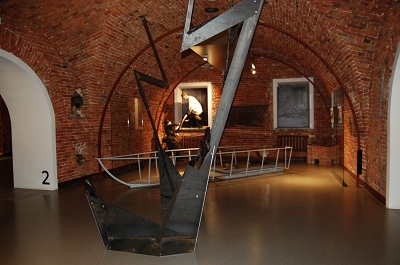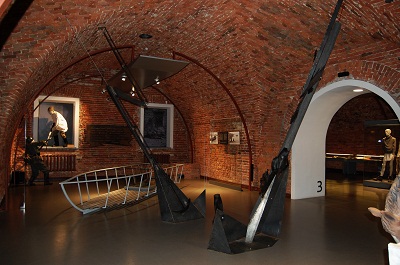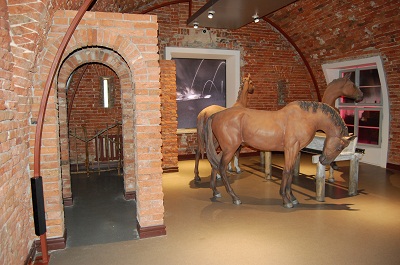Hall 2. «Battle»
On the 22nd of June 1941, at 4:15 o’clock, the Brest fortress was attacked by the units of the 45th infantry division of the 4th Wehrmacht army. For this first sudden strike, the enemy’s division was forced with base artillery, regiment of chemical mortars and special power weapons “Carl”. The fortress was exposed to fierce artillery fire. Warehouses, caserns, artillery parks and family houses were under attack. More than 5000 concrete-piercing, armor-piercing, splinter and smoke shells hit the fortress walls together with mines and grenades. The Brest-Litovsk battle report from the 45th infantry division from the 8th July 1941 states that: “The artillery fire is less aimed on real impact, but more on suddenness…”.


The central composition of the hall is the explosion installation, made of various daily life objects, shell fragments and mines. Together with the sound and light accompaniment, this installation symbolizes the war treachery and chaos. Already in 4 minutes, at 4:19, the advanced enemy groups rushed to the opposite bank of the Western Bug with their assault boats. In the left half of the hall you can find a frame model of the German assault boat with a glass case next to it, where different weaponry, equipment and daily life objects of a German soldier can be found. In June 1941, German press photographers created a film for the propaganda newsreel “Die Deutsche Wochenschau”, featuring the pictures of the Brest Fortress and Wehrmacht soldiers. On the right window of the left half of the hall you can see a picture called “German machine-gun crew fights the battle in the fortress”. On the wall on the right there is another picture called “German assault group crosses the water barrier”. The picture “Night battle in the fortress” can be found on the window of the right half of the hall, while the picture “Burning houses of the commanding crew” is in the wall aperture on the right. The suddenness of the German attack was the reason for the huge losses of fortress garrison crew and family members of the commanding officers. However, already during the first war hours, the Red Army fighters resisted the enemy. The installation in the left half of the hall called “Confrontation” mirrors one of the first encounters between the two opposite sides. It highlights the full equipment of the fascist soldier and the hastily dressed soviet fighter.

The shells, mines and grenades explosions ruined buildings, burned trees, killed people and animals. The war beginning tragedy is portrayed through the horses’ figures, the models of which are standing in the right half of the hall. One of the fortress defenders, I. Dolotov, was telling the following story: “As fascist shells were exploding by the back wall of the White palace, the wooden stables next to it caught fire first. Terrified horses with messy manes and crazy eyes were trying to escape the fire. They were bumping against trees, standing up and … running again. Their long neighing was drowning in constant thunder of explosions. There was no rescue from this small space embraced by war”. The battles in the fortress took a different way, the one that the enemy was not expecting. A number of separate centers of resistance have been organized. Considering the lack of water, food, weapons, ammunition and medical supplies, the fortress defenders delivered significant strikes to the enemy. They kept on fighting in those incredibly hard conditions and attempted to escape the besiegement. Trying to break through, a lot of people died or got captured. The battles in the fortress lasted until the end of June 1941. The last center of resistance, the East Fort, was taken on the 30th of June. However, even in July 1941, some of the last defenders still remained in the fortress. Major Pyotr Gavrilov fought his last battle on the 23rd of July 1941 in the caponier next to the North Gate, after which he was taken captive on the 32nd day of the war. The improvised caponier takes the left part of the right half of the hall, from where you can enter the Hall 3. In the caponier you can find a writing on the wall, saying “Dying for the Homeland”. This writing symbolizes all other writings, left by the known and unknown fortress defenders during the days of its defense.
